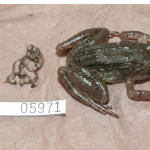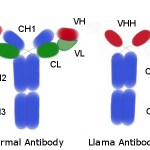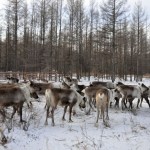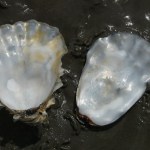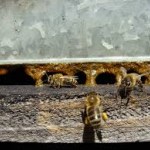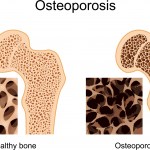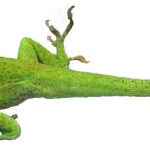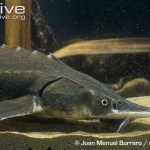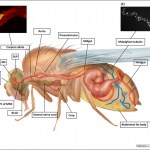Life Science
Few fish can survive the immense pressure of living in the deep sea. The Mariana Trench can reach around 36,200 feet deep with pressures of over 1,000 atmosphere. Scientists have placed landers at various depths ranging from 16,400-34,750 feet along the walls of the trench and have discovered what appears to be the "World's Deepest Fish". The fish was found at 26,872 feet which is estimated to be near the lower limit for bony fishes (of 27,600 feet). This newly discovered fish has what look like wings and tentacles. The video below was captured by the Hadal Ecosystem Studies expedition (HADES…
Male (left) and female L. Larvaepartus frogs discovered in Sulawesi, Indonesia. Image from Figure 2 of PLOS ONE article.
A new species of frog (Limnonectes larvaepartus) has been discovered in the rain forest of Sulawesi island in Indonesia. This species challenges the grade-school wisdom that taught us: 'frogs lay eggs'. It looks like textbooks will need to be revised as this is the only known exception to that rule. Study author Dr. Jimmy McGuire (University of California, Berkeley) said the following as quoted in Reuters, "Reproduction in most frogs could not be more…
Image of llama from www.healthline.com
Research has suggested that llamas may pack a powerful punch against HIV. This is because they not only have conventional heavy and light chain antibodies like those found in humans, they also have heavy chain-only antibodies as shown below.
Depiction of conventional antibody with heavy and light chains (left) and the heavy chain only antibody found in llamas (right). Figure from www.abcore-inc.com
These so-called "llama antibodies" are smaller than the conventional antibodies found in humans. This helps the antibodies bind more effectively to…
Image of Aoluguya reindeer from www.chinatouradvisors.com
Scientists have now determined the complete mitochondrial genome sequence of Aoluguya reindeer (Rangifer tarandus). I wonder if the sequence will hold any more clues as to why Rudolph's nose is so red and bright. Although according to this prior blog entry perhaps it was the other 8 reindeer who were different...
Source:
Ju Y, Liu H, Rong M, Yang Y, Wei H, Shao Y, Chen X, Xing X. Complete mitochondrial genome sequence of Aoluguya reindeer (Rangifer tarandus). Mitochondrial DNA. 3:1-2, 2014. [Epub…
Photo credit: Pixabay as posted in Discovery News
New research shows that pearlfish (Onuxodon fowleri) not only reside in black-lip pearl oyster shells, they also use the shells to amplify sounds created by vibrating their swimbladders. According to lead study author Dr. Loic Kéver, "amplification probably improves the efficiency of communication by increasing the propagation distance of the sounds."
Following high resolution CT scans, Dr. Kéver noted, "the rostral [front] end of the swimbladder forms a mineralised structure – called the rocker bone – on which insert the…
Ever wonder what lies beneath the polar ice? Turns out several researchers did as well. This past July a team of scientists led an expedition designed to image life under sea ice. The video below was captured with the Nereid Under Ice (NUI) vehicle and shows brown algae living on the bottom of sea ice as well as larvaceans, which are filter-feeding tunicates. The advantage of the new vehicle is that it can travel very far (the spools of cable are ~40 km long) and allows researchers to create maps and collect samples. Researchers are hoping to explore greater distances in future dives that…
Image from APiS UK
Propolis is a resin-like compound honeybees collect to coat their hives. New research suggests that this compound may increase hair growth as observed in studies of mice. Although the researchers did not test propolis on balding mice, they did find faster hair growth in mice that had been shaved or waxed, which is somewhat promising.
Source:
Miyata S, Oda Y, Matsuo C, et al. Stimulatory Effect of Brazilian Propolis on Hair Growth through Proliferation of Keratinocytes in Mice.J. Agric. Food Chem. 2014.
New research from Vanderbilt University shows that hummingbirds and insects have a lot in common...when it comes to flying at least. The researchers placed nontoxic paint on the wing of a ruby-throated hummingbird at 9 different spots then videotaped the animal flying at 1,000 frames per second with 4 cameras simultaneously. Using 3D simulations of the hummingbird flight, they discovered that the tiny birds stir up air around their wings in a way similar to insects like mosquitoes and dragonflies.
Larger birds obtain much of their energy for flight from the downstroke of the wing as it pushes…
Image from Scientific American (Credit: S Gart, J Socha, Vlachos, Jung)
I have to be honest. I have always wondered whether my dog actually got any water in his mouth. It always seemed to me that the majority of water ends up on my floor. High speed video collected and analyzed by a team of researchers from Virginia Tech (Sean Gart, Jake Socha and Sunghwan Jung) and Purdue University (Pavlos Vlachos) has shown exactly how a dog is able to drink water...and also explains why they are so messy doing it. Their research was presented at the 67th Annual Meeting of the American Physics…
Image from The Telegraph (www.telegraph.co.uk Photo credit: Alamy)
Granted this is not comparative physiology, I thought this study was really interesting.
Research has shown that exposure of developing embryos to caffeine in utero can alter the expression of genes in the heart leading to changes in how the heart develops and functions in adult animals. New research from the University of Florida published in the American Journal of Physiology - Regulatory, Integrative and Comparative Physiology has examined changes in specific genes they believe are altered by physiologically-…
Image from www.chow.com
Did you know that the typical Thanksgiving day broad-breasted white turkey develops in as little as 136 days (on average)? This remarkably quick development is a result of years of selective breeding. The average turkey in 1929 was only about 13 pounds, whereas modern turkeys average around 30 pounds with much of the weight centered in the breast muscles.
The Poultry Science Association claims that this breeding program has resulted in skeletal problems as muscle growth outpaces bone growth, heart problems, and a lower ability to mount immune responses to…
I came across this interesting literature on what foods you should avoid feeding a dog from the ASPCA Animal Poison Control:
Jeff Cremer, a nature photographer, discovered mysterious tiny glow worms (~0.5 inches long) in Peru near the Tambopata Research Center a couple of years ago. Scientists still have not identified the species of these glow "worms", but suspect they are actually click beetle larvae. Entomologists Aaron Pomerantz, Mike Bentley, and Geoff Gallice from the University of Florida decided to go to Peru to investigate the worms. Here is what they found:
I recently received the following question from a reader based on a prior blog entry on how a medication used to treat epilepsy also helps reverse memory loss with Alzheimer's disease. You can see the original blog here
Question:
"I find it a little confusing as to how it is possible that this medication can improve brain and memory function but at the same time cause cognitive impairment? Is that not contradictory that the meds are suppose o help the brain but the side effects are related to the brain? Did the research account the facts that humans do not share all the same proteins as…
Comparison of normal bone (left) with osteoporosis (Image from www.medguidance.com)
A recent review published by Dr. Graziana Colaianni (University of Bari, Italy) and colleagues in the American Journal of Physiology - Regulatory, Integrative and Comparative Physiology, has summarized recent research on the role of the hormone oxytocin in the regulation of bone mass.
Bone remodeling and rebuilding are constantly occurring in our bodies. Osteoporosis is a condition that develops when the process of building new bone does not keep up with the process of breaking down "old" bone tissue…
A reader sent me the following question:
"How does a lizard grow a new tail?"
This was a very timely question as new research has shed light on this very phenomenon. A team of experts at Arizona State University led by Dr. Kenro Kusumi and colleagues have been studying limb regeneration in lizards.
Green anole lizard (Anolis carolinensis) with tail a new tail (image credit: Hutchins et al./PLoS ONE)
The green anole lizard (pictured above) can lose its tail when captured by a predator. They are then able to regrow their tails, although they do not look quite like the original. Dr.…
Siberian sturgeon in captivity
Drs. Thomas Eliot Haworth and Holly Shiels (University of Manchester) teamed up with Drs. Jaakko Haverinen and Matti Vornanen (University of Eastern Finland) to explore how electrical signaling in the hearts of fish have evolved by comparing Teleost fish with sturgeons. Their findings were published this month in the American Journal of Physiology - Regulatory, Integrative and Comparative Physiology.
According to the study authors, there are currently approximately 27,000 species of ray-finned fishes which make up 99% of all fishes existing today. Teleost…
Just in case you felt like casting a vote for a cute and cuddly cause, the Phoenix Zoo is asking for help in naming a new baby Bornean orangutan. He was born on September 2, 2014 to parents Bess and Michael.
You can vote here
Voting ends November 6th and the winning name will be announced at his/her baby shower on the 8th.
Image of baby orangutan from the Phoenix Zoowww.phoenixzoo.org
Enjoy this video of how animals at the Brookfield Zoo celebrated Halloween early this year. Happy Halloween!
A recent study published in the American Journal of Physiology - Regulatory, Integrative and Comparative Physiology presents evidence that altering the sex of just the fat body in heads of fruit flies (Drosophila) causes them to have stress responses similar to the opposite sex.
Males and females vary in their response to stress. It turns out that this difference is not unique to mammals as male and female fruit flies also show similar variations. In fruit flies this is thought to be due to differences in the neuronal circuits between the sexes, which may also explain some of the variability…
